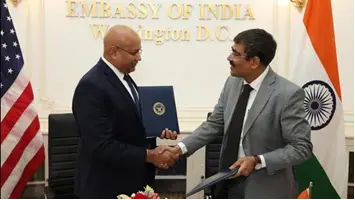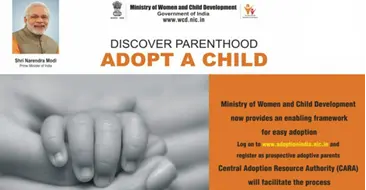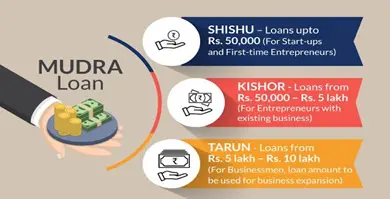Saturday, 31st August 2024
Moving the Spotlight to Grassroots Democracy
Why in the news?
- The Election Commission of India (ECI) is widely recognized for its role in conducting free and fair elections at the national and state levels.
- With 34 SECs across India needing significant enhancement, there is an urgent need to focus on strengthening these institutions to fulfil their constitutional responsibilities effectively.
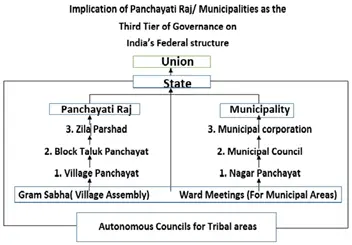
The Systemic Disempowerment of State Election Commissions (SECs):
- A Significant Challenge:
- Establishment of SECs: SECs were created under Articles 243K and 243ZA of the Constitution via the 73rd and 74th Amendments in 1993 to decentralise governance.
- Intended Functions: They oversee electoral rolls and elections for panchayats and urban local governments (ULGs).
- Reality Check: Despite constitutional mandates, SECs often find themselves powerless and undermined by state governments.
- Legal and Institutional Constraints:
- Conflicts with State Governments: Frequent conflicts between SECs and state governments arise due to reluctance in ceding control over local elections.
- Case Studies Exemplifying Disempowerment of SECs:
- Karnataka Case: Elections were delayed by over three and a half years, with the government not fulfilling its December 2023 promise to publish delimitation and reservation details.
- Andhra Pradesh Case: In 2020, the Andhra Pradesh SEC faced similar issues with delays in publishing delimitation and reservation rosters, leading to irregular elections and accusations of intentional delays by the state government.
- Performance Audit Findings: A CAG audit found that 70% of urban local governments (1,560 out of 2,240) lacked elected councils, highlighting significant systemic issues in local governance.
Impact of Disempowerment of SECs:
- Weakened Local Governance:
- Governance Vacuum: Delays in SECs conducting elections result in local bodies lacking elected representatives, creating a governance vacuum.
- CAG Audit Findings: Performance audits by the Comptroller and Auditor General (CAG) reveal that 70% of urban local governments lacked elected councils due to election delays linked to SEC disempowerment.
- Erosion of Public Trust:
- Loss of Confidence: Delays or questionable elections lead to diminished public trust in the electoral process and government institutions.
- ASICS Survey Findings: The Annual Survey of India’s City Systems (ASICS) found that only 11 out of 34 states and UTs empowered their SECs to conduct ward delimitation, affecting 35% of India’s population.
The Need for Electoral Reforms:
- Importance of Reforms:
- Comprehensive electoral reforms are necessary to strengthen local governments and ensure timely, fair elections.
- Supreme Court Ruling:
- The Supreme Court in the 2006 Kishan Singh Tomar vs Municipal Corporation of the City of Ahmedabad case emphasised the need for SECs to have equivalent powers for conducting local elections.
Necessary Reforms to Empower SECs in the Interest of Grassroots Democracy:
- Empowerment and Independence of SECs:
- Current Appointment System: SECs are appointed by state governments, leading to potential conflicts of interest.
- Proposed System: A three-member SEC appointed by a committee (Chief Minister, Leader of Opposition, Chief Justice of the High Court) to enhance independence and credibility.
- Fixed Delimitation Intervals:
- Regular Intervals: Delimitation and reservation of seats should occur at fixed intervals (e.g., every 10 years) to prevent delays and ensure fairness in the electoral process.
- Vesting Powers in SECs:
- Exclusive Powers: SECs should have exclusive authority over ward delimitation, seat reservations, and determining reservations for key local government positions.
- Current Issues: Delays by state governments in publishing reservation details have impacted local elections and the democratic process.
- Addressing Malpractices:
- SEC Oversight: SECs should oversee elections for mayors and other local positions to prevent malpractices.
- Case Example: Instances such as the 2024 Chandigarh Municipal Corporation Council mayoral election highlight the need for SEC management to ensure fair processes.
Conclusion:
The issues faced by SECs reflect broader challenges in India’s democratic framework and the incomplete realisation of decentralisation. Enhancing SECs’ autonomy, transparency, and authority is crucial for effective local governance and restoring public trust in these institutions.
Source: TH
Controversy Over Lateral Entry into the Civil Services
Why in the news?
- The Union Public Service Commission (UPSC) recently retracted an advertisement for 45 government posts due to objections about reservation requirements, prompted by political parties and the Prime Minister's Office (PMO).
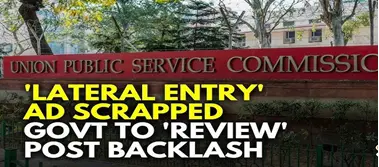
Understanding Merit vs. Spoils System:
- Merit System:
- Introduced in 1858, this system ensures appointments based on a rigorous selection process, with UPSC conducting exams for IAS, IPS, and other central services to foster a neutral bureaucracy.
- Spoils System:
- Originating in the U.S., this system allowed the ruling party to appoint its supporters, largely replaced by the merit system in 1883, but still partially exists with some senior posts appointed directly by the President.
Lateral Entry in Civil Services:
- Objective:
- Purpose: Lateral entry aims to infuse domain expertise into civil services and address the shortage of IAS officers by recruiting specialists from various sectors to enhance governance.
- Process:
- Recruitment: The Department of Personnel and Training (DoPT) coordinates with UPSC to invite applications, conduct interviews, and recommend candidates for government appointments, typically for 3-5 years.
- Need for Lateral Entry:
- Officer Shortage: There is a 22.48% shortage of IAS officers and a combined shortage of 2,418 for IAS and IPS.
- Domain Expertise: Lateral entry helps bring private sector experts into government roles, improving efficiency and competitiveness.
- Pros of Lateral Entry:
- Expertise and Specialization: Professionals with private sector experience bring specialised knowledge, improving policy making and governance.
- Innovation and Fresh Perspectives: New entrants offer innovative approaches and fresh perspectives, potentially enhancing public administration effectiveness.
- Merit-Based Selection: Emphasises merit and skills over seniority, fostering a performance-oriented culture.
- Shortening Learning Curve: Experienced professionals can contribute immediately, reducing the need for extensive training.
- Cons of Lateral Entry:
- Cultural and Bureaucratic Resistance: Traditional bureaucrats may resist newcomers, leading to integration challenges and friction.
- Lack of Public Sector Experience: New entrants may lack familiarity with government procedures, affecting their effectiveness.
- Potential for Bias: Selection processes could be perceived as politically influenced, raising concerns about fairness.
- Short-Term Focus: Lateral entrants might prioritise short-term goals over long-term public service, affecting policy continuity.
- Way Forward:
- Higher Scrutiny: Ensure that high-level appointments positively impact policy decisions.
- Integration with Public Policy: Align lateral entrants with public policy objectives even at operational levels.
- Balancing Merit with Social Justice: Combine technical competence with considerations for reservation and social justice.
- Larger Issues in Indian Bureaucracy:
- Challenges for Career Bureaucrats: Despite criticisms, career bureaucrats navigate complex rules and political interference.
- Preserving Autonomy: Strengthening Civil Service Boards at the Centre and State levels, as recommended by the Supreme Court in the T.S.R. Subramanian case (2013), is crucial for maintaining bureaucratic effectiveness.
Conclusion:
Lateral entry offers benefits but should be balanced with addressing fundamental issues within the Indian bureaucracy. A holistic approach integrating career bureaucrats and lateral entrants, focusing on merit, social justice, and autonomy, is essential for effective governance.
Source: TH
Incentivising Semiconductor Manufacturing in India
Why in the news?
- Recently, the Indian government, having nearly exhausted the $10 billion subsidy under its semiconductor manufacturing incentive policy, is planning a second phase with a $15 billion outlay.
- This expansion aims to provide capital support for raw materials and gases used in chip manufacturing, while reducing subsidies for assembly and testing plants.
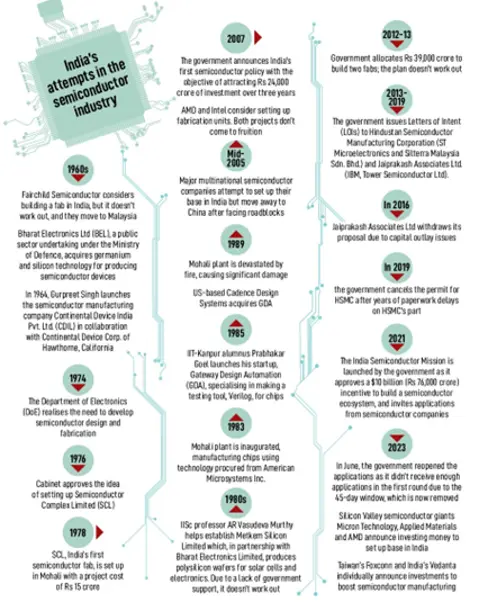
India’s Semiconductor Ambitions;
- Background:
- Importance of Semiconductors:
- Semiconductors form the backbone of modern electronics, playing a crucial role across various industries.
- Global strategies are being formulated to reduce reliance on a single supply source for semiconductor chips to enhance national security and economic stability.
- Importance of Semiconductors:
- Advantages to India:
- Talent and Market:
- India hosts 20% of the world’s semiconductor design workforce and has a rapidly evolving technology landscape alongside a thriving domestic market.
- These factors create a favourable environment for building an indigenous semiconductor ecosystem.
- Talent and Market:
- Sustaining the Momentum:
- Accelerating Initiatives:
- Past efforts to enter the global semiconductor industry have faltered due to slow policy implementation.
- To avoid repeating past mistakes, the government must ensure swift execution of policies under the new strategy.
- Advancing the Value Chain:
- India can strategically move across the semiconductor industry value chain to establish a complete ecosystem.
- Leveraging Talent:
- It is estimated that India will need 1.2 million skilled professionals in the semiconductor sector by 2032.
- Developing the talent ecosystem rapidly is imperative as the demand for skilled workers rises.
- Accelerating Initiatives:
Major Leap into Semiconductor Manufacturing:
- Global Scenario:
- Industry Concentration:
- The global semiconductor industry is dominated by a few key players, notably Taiwan, South Korea, and the U.S., with Taiwan's TSMC responsible for 90% of the world's 5 nm chip production.
- Geopolitical Impact:
- Global chip shortages, coupled with U.S.-China tensions over Taiwan and supply chain disruptions from the Russia-Ukraine conflict, have prompted major economies to reinvest in domestic chip-making.
- Industry Concentration:
- Market Size:
- The semiconductor industry is valued at approximately USD 500-600 billion, integral to the global electronics market, which is valued at about USD 3 trillion.
- Indian Scenario:
- India’s semiconductor market, currently valued at USD 23.2 billion, is expected to surge to USD 150 billion by 2029, with a compound annual growth rate (CAGR) of 27.10%.
- Government Initiatives:
- Initiatives like the National Electronics Policy and the $10 billion Production Linked Incentive (PLI) scheme are propelling India’s semiconductor manufacturing ambitions.
- Attracting Foreign Investment:
- India has attracted foreign companies to establish operations, including:
- A $11 billion fabrication plant by Tata Electronics in partnership with Taiwan’s Power chip.
- Chip assembly plants by Tata, US-based Micron Technology, and Murugappa Group’s CG Power in partnership with Japan’s Renesas.
- India has attracted foreign companies to establish operations, including:
- Strategic Blend:
- With a proactive approach, tech skills development, infrastructural improvements, and fiscal investments, India is well-positioned to achieve its semiconductor manufacturing goals.
The Semiconductor Manufacturing Incentive Policy:
- First Iteration (2021):
- Initial Subsidy:
- The Centre offered a 30% capex subsidy for chip packaging and testing plants.
- Increased Subsidy (2022):
- The subsidy was later increased to 50% for such plants.
- Initial Subsidy:
- Semiconductor Manufacturing Incentive Policy 2.0:
- Focus on Chip Fabrication:
- India aims to advance in the semiconductor ecosystem by focusing on fabrication plants and more advanced display technologies, moving beyond assembly and packaging facilities where countries like Malaysia are already strong.
- Technology Transfer Costs:
- The new scheme will not support technology transfer costs, requiring companies to bear these expenses when collaborating for chip fabrication.
- Capital Equipment and Ecosystem Support:
- The new scheme may include support for capital equipment and essential ecosystem resources like gases, chemicals, and raw materials needed at assembly and testing plants.
- It may also provide incentives for the fabrication of micro-LED displays
- Focus on Chip Fabrication:
|
UPSC Civil Services Examination, Previous Year Question (PYQ) Prelims: Q:1 Which one of the following laser types is used in a laser printer? (2008)
Ans: (c)
Q:2 With reference to solar power production in India, consider the following statements: (2018)
Which of the statements given above is/are correct?
Ans: (d) |
Source: IE
Cryptocurrency and Blockchain
Why in the news?
- Former US President Donald Trump recently expressed support for Bitcoin at a crypto event.
- Rising dissatisfaction with traditional financial systems and economic issues is fuelling interest in cryptocurrencies.
- This trend, driven by a desire for financial autonomy and belief in blockchain’s potential, faces uncertainty regarding its long-term viability.
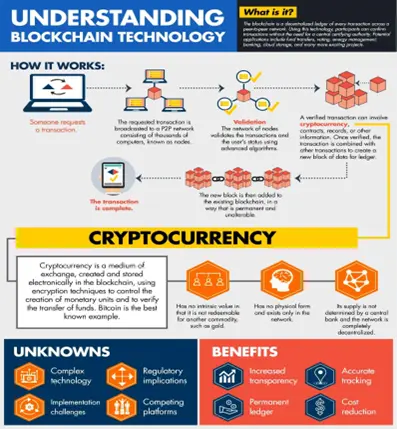
What is Cryptocurrency and How Does it Work?
- Definition: Cryptocurrency is a decentralised digital currency secured by cryptography, with notable examples including Bitcoin, Ethereum, Ripple, and Litecoin.
- Transactions: Managed on a public ledger known as the blockchain, maintained by a global network of computers that validate and record transactions.
- Process: Users require a digital wallet to store cryptographic keys necessary for transactions. Cryptocurrencies are acquired through mining, where computational power solves complex mathematical problems to verify transactions.
What is Blockchain Technology?
- Definition: Blockchain is a decentralised digital ledger recording transactions across a network. Each block in the chain contains multiple transactions, adding a record to every participant’s ledger, ensuring security and transparency.
- Applications: Beyond cryptocurrencies, blockchain is used by financial institutions for secure transactions and has potential applications in areas such as student record management and scholarship systems.
What is the Legal Status of Cryptocurrency in India?
- Regulation: Cryptocurrencies are unregulated but not banned. They are not recognized as legal tender, and the government aims to limit their use in illegal activities.
- Taxation: As of 2022, any transfer of cryptocurrency is subject to a 30% tax.
- CBDC: India’s Central Bank Digital Currency (CBDC), called Digital Rupee, is legally backed by the central bank and operates on blockchain technology, differing from decentralised cryptocurrencies.
Pros and Cons of Cryptocurrency:
- Pros:
- Security and Transparency: Blockchain technology offers enhanced security and transparency, reducing fraud and operational costs.
- Innovation and Tokenization: Enables the creation of new financial instruments and asset management models.
- Global Finance: Potential to transform global financial systems and enhance financial inclusion.
- Financial Autonomy: Provides alternatives to traditional banking systems, beneficial in regions with unstable economies.
- Cons:
- Volatility: The speculative nature of cryptocurrencies leads to extreme price volatility, limiting their use as a stable medium of exchange.
- Regulatory Uncertainty: Fluctuating regulations create challenges for integration and innovation.
- Limited Acceptance: Restricted use by financial institutions and merchants complicates practical utility and integration with traditional systems.
- High Costs: Cryptocurrencies often involve high transaction fees and slower processing compared to traditional methods.
Conclusion:
The rapid growth of cryptocurrency in India reflects a move towards digitalization but is accompanied by challenges due to the lack of a regulatory framework. This gap introduces risks such as fraud and financial crimes. Establishing robust regulatory oversight is essential to address these issues and secure the crypto market.
|
UPSC Civil Services Examination, Previous Year Question (PYQ) Prelims: Q:1 With reference to “Blockchain Technology”, consider the following statements: (2020)
Which of the statements given above is/are correct?
Ans: (d)
Q:2 Consider the following pairs: (2018) Terms sometimes Context/Topic seen in news
Which of the pairs given above is/are correctly matched?
Ans: (b)
Mains: Q:1 Discuss how emerging technologies and globalisation contribute to money laundering. Elaborate measures to tackle the problem of money laundering both at national and international levels? (2020) Q:2 What is Cryptocurrency? How does it affect global society? Has it been affecting Indian society also? (2019) |
Tamil Nadu to nationalise Karunanidhi's work
- The Tamil Nadu government has declared that the works of former Chief Minister M. Karunanidhi will be "nationalised," allowing public access for publishing, translating, and adapting these works freely.
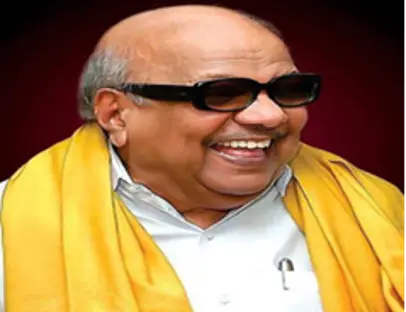
Key Features of the Copyright Act, 1957
- Background: Copyright is an intellectual property right protecting original works like literature, music, and art. Under Section 13 of the Copyright Act, 1957, copyright safeguards the expression of ideas rather than the ideas themselves.
- Key Provisions:
- Exclusive Rights: Authors have exclusive rights to reproduce, distribute, perform, translate, and adapt their works (Section 14).
- Duration of Protection: Lasts for the author’s lifetime plus 60 years; for photographs, sound recordings, and films, 60 years from publication.
- Assignment of Rights: Authors can transfer rights, wholly or partially, as per Section 18.
- Public Domain: Works enter the public domain after copyright expires, becoming freely accessible.
- Moral Rights: Authors have the right to claim authorship and object to modifications that harm their reputation.
- Infringement and Remedies: Includes civil remedies (injunctions, damages) and criminal penalties.
- Fair Use Doctrine: Permits certain uses like criticism and education without needing permission.
- Compulsory Licensing: Allows government-sanctioned use of works for public interest without the owner’s consent.
Copyright Laws and Nationalisation of Copyright
- Copyright Laws: Authors hold rights to reproduce, adapt, and translate their works. Posthumously, these rights are inherited by legal heirs.
- Nationalisation in Tamil Nadu:
- The Tamil Nadu government established the Tamil Virtual Academy (TVA) in 2001 to facilitate Tamil language education online.
- TVA collaborates with legal heirs to nationalise works, which are then placed in the public domain and accessible for free use via TVA’s website.
- Tamil Nadu has nationalised 179 Tamil scholars' works and paid Rs 14.42 crore in royalties.
Case of Ambedkar's Works
- Historical Context: In the 1960s, Prakash Ambedkar granted copyright of Dr. B. R. Ambedkar's works to the Maharashtra government.
- Publication: The Maharashtra government published Dr. Ambedkar's works in a 22-volume series starting in 1979.
- Recent Developments: In 2016, copyright was transferred to Symbiosis Centre, which now manages translations and digitization.
- Current Status: The Maharashtra government retains rights to some works, distributed through specific institutions. In 2018, there was a request to remove Dr. Ambedkar’s works from the Centre, reflecting ongoing copyright discussions.
Source: TH
RESET Programme
Why in the news?
- The Union Minister of Youth Affairs & Sports and Labour & Employment recently launched the "Retired Sportsperson Empowerment Training" (RESET) Programme on National Sports Day in New Delhi.
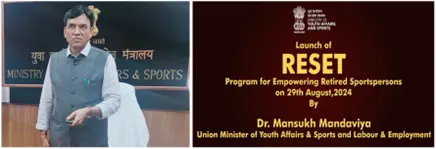
About RESET Programme:
- The RESET Programme is designed to empower retired athletes who have represented India and brought laurels to the nation.
- The programme aims to support the career development of retired athletes by equipping them with necessary knowledge and skills, thereby enhancing their employability.
- It marks a significant initiative to recognize and utilise the experience and expertise of retired athletes.
Eligibility Criteria:
- The programme is open to retired athletes aged 20-50 years.
- Eligible candidates include those who have won international medals, participated in international events, won national or state medals, or participated in competitions recognized by National Sports Federations, Indian Olympic Association, or the Ministry of Youth Affairs and Sports.
- The RESET Programme offers two levels based on educational qualifications:
- Level 1: Class 12th and above.
- Level 2: Class 11th and below.
Implementation:
- Lakshmibai National Institute of Physical Education (LNIPE) will be the lead institute for implementing the RESET Programme.
- The programme will be delivered in a hybrid mode, combining self-paced learning through a dedicated portal with on-ground training and internships.
- Internships will be provided in sports organisations, competitions, training camps, and leagues.
- Successful participants will receive placement assistance and guidance for entrepreneurial ventures.
Source: PIB
Unified Payments Interface (UPI) block mechanism
Why in the news?
- The Securities and Exchange Board of India (SEBI) has proposed making the Unified Payments Interface (UPI) block mechanism mandatory for secondary market trading.
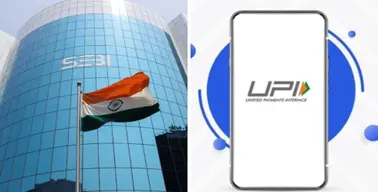
Unified Payments Interface (UPI) Block Mechanism:
- About:
- The UPI block mechanism is similar to the Application Supported by Blocked Amount (ASBA) facility, allowing trading with blocked amounts.
- In the primary market, this facility ensures that funds are transferred only after the allotment is completed.
- For the secondary market, the UPI block mechanism allows clients to trade based on funds blocked in their bank accounts, rather than transferring the funds upfront to the trading member.
- Currently, this facility is optional for investors and not mandatory for Trading Members (TMs) to offer as a service.
- Significance:
- The UPI block mechanism provides enhanced protection to clients' funds and securities.
Key Facts about Application Supported by Blocked Amount (ASBA):
- ASBA was introduced by SEBI in 2008.
- It is a process used for making Initial Public Offerings (IPOs) or rights issue subscriptions.
- ASBA allows investors to apply for IPOs or rights issues by blocking the application amount in their bank account without transferring the funds to the issuer.
- The application money remains in the investor's account, with only a block created for the IPO application amount.
- Once shares are allotted, the block is released, and the amount for the allotted shares is deducted from the investor's account.
- ASBA is mandatory for all investors applying in public issues and rights issues.
Source: TH
Sabina Shoal
Why in the news?
- Recently, China's natural resource ministry has released its first survey report on the disputed Sabina Shoal in the South China Sea.

About Sabina Shoal:
- Alternative Name: Sabina Shoal is also known as Xianbin Reef.
- Geographical Location:
- It is an oceanic coral atoll situated on top of a seamount in the eastern part of the Spratly Islands in the South China Sea.
- The shoal is approximately 75 nautical miles from the Philippine province of Palawan.
- Legal Status:
- Sabina Shoal is within the Philippines' 200-nautical mile Exclusive Economic Zone (EEZ), as defined by the 1982 United Nations Convention on the Law of the Sea (UNCLOS).
- Dispute:
- Despite its proximity to the Philippines, China claims Sabina Shoal, along with much of the South China Sea, as its sovereign territory.
- The shoal is about 630 nautical miles from China, yet China has maintained a continuous presence in the area.
- Physical Characteristics:
- The shoal extends close to 23 km along its northwest-southeast axis.
- It consists of two main parts connected by a narrow section.
- The western part is larger, measuring 13 km long by 6 km wide, while the eastern part measures 10 km by 3 km.
- Both parts have a central lagoon, surrounded by a coral ring with discontinuous shallow sections.
Source: DH
SHe-Box (Sexual Harassment e-box) Portal
Why in the news?
- The Union Ministry of Women and Child Development has recently launched the new SHe-Box portal.
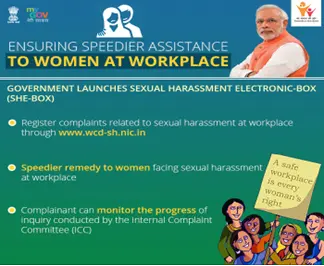
About SHe-Box Portal:
- Purpose:
- The SHe-Box (Sexual Harassment e-Box) Portal is a centralized platform designed for the registration and monitoring of complaints related to sexual harassment of women in the workplace.
- Functionality:
- It acts as a centralised repository of information regarding Internal Committees (ICs) and Local Committees (LCs) established across India, covering both government and private sectors.
- The portal provides a common platform where women can file complaints, track their status, and ensure time-bound processing by the relevant ICs.
- It assures the redressal of complaints and streamlines the process for all stakeholders involved.
- Key Features:
- Real-time monitoring of complaints is facilitated through a designated nodal officer.
- The portal ensures that personal information remains confidential, allowing women to safely register complaints without their details being publicly accessible.
- The SHe-Box portal can be accessed online at https://shebox.wcd.gov.in/.
- Points to Remember:
- In 2017, an upgraded version of the SHe-Box portal was launched, in line with The Sexual Harassment of Women at Workplace (Prevention, Prohibition, and Redressal) Act, 2013.
- Under this framework, women facing harassment at any workplace can file a complaint on the SHe-Box portal.
- For private institutions, an Internal Committee (IC) is formed, while for government institutions, a Local Committee (LC) is established under the chairmanship of the District Magistrate (DM), Deputy Commissioner (DC), or an officer appointed by them, with actions being taken accordingly.
Source: NEWS18
Biotech enigma: On the BioE3 proposal and beyond
Context:
- India's Cabinet has approved the BioE3 (Biotechnology for Economy, Environment and Employment) proposal to enhance biotechnology manufacturing.
- The BioE3 policy targets bio-based chemicals, functional foods, precision biotherapeutics, climate-resilient agriculture, carbon capture, and marine/space research.
- To maximise impact, India must foster long-term investment and government collaboration in biotechnology.
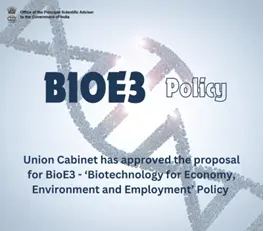
Current Status of India’s Biotechnology Sector:
- Global Ranking:
- India is among the top 12 global biotechnology destinations.
- It ranks as the 3rd largest biotechnology destination in the Asia-Pacific region.
- Market Value:
- India’s Bioeconomy was valued at approximately USD 130 billion in 2024.
- Economic Contribution:
- Biotechnology is a sunrise sector, significantly contributing to India’s goal of becoming a USD 5 trillion economy by 2024.
- India holds about 3% of the global biotechnology market share, establishing itself as a hub for innovative and affordable healthcare solutions.
Biotechnology Categories in India:
- Biopharmaceuticals:
- India is a leading global supplier of low-cost drugs and vaccines.
- It is a pioneer in biosimilars, with the highest number of biosimilars approved in the domestic market.
- Bio-Agriculture:
- Approximately 55% of Indian land is used for agriculture.
- India has the 5th largest area of organic agricultural land globally.
- The Bio-Agriculture sector’s contribution to the Bio Economy is projected to nearly double from USD 10.5 billion to USD 20 billion by 2025.
- Bio-Industrial:
- Biotechnology is transforming industrial processes, manufacturing, and waste disposal across the country.
- Bio IT & BioServices:
- India has strong capabilities in contract manufacturing, research, and clinical trials.
- It hosts the highest number of US FDA-approved plants outside the United States.
Government Initiatives:
- Foreign Direct Investment (FDI):
- 100% FDI is permitted under the automatic route for greenfield pharma and medical device manufacturing.
- Favourable FDI policies include specific routes for brownfield pharma and medical devices.
- National Biotechnology Development Strategy 2021-25:
- Aims to make India globally competitive in biotechnology research, innovation, translation, entrepreneurship, and industrial growth.
- Targets a USD 150 billion Bioeconomy by 2025.
- Biotech-KISAN Hubs:
- Funded by the Department of Biotechnology, these 51 hubs connect farmers with scientists and institutions, focusing on sustainable agriculture practices, soil health, irrigation, and new Agri-technologies.
- Gobardhan Scheme:
- Under the Union Budget 2023-24, 500 new ‘waste to wealth’ plants are planned with a total investment of INR 10,000 crore.
- Genome India Project:
- Aims to sequence and analyse the genomes of a representative Indian population to understand genetic diversity and its implications for public health.
- First National Biotechnology Development Strategy:
- Announced by the Department of Biotechnology (DBT) in September 2007.
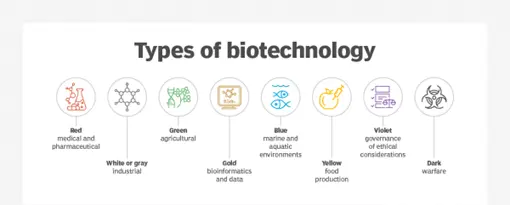
Significance of Biotechnology for India:
- Economic Powerhouse:
- India’s biotech industry is projected to reach USD 150 billion by 2025, showcasing its potential for explosive growth.
- Success stories like Biocon highlight the global competitiveness of Indian biotech firms.
- Government initiatives, including BioE3 and the Biotechnology Industry Research Assistance Council (BIRAC), aim to spur growth, create millions of high-skilled jobs, and boost India's GDP.
- Vaccine Prowess:
- India is renowned as the "pharmacy of the world" due to its significant role in global vaccine production, accounting for 60% of the total.
- It supplies 40-70% of the WHO’s demand for Diphtheria, Tetanus, and Pertussis (DPT) vaccines.
- During the Covid-19 pandemic, the Serum Institute of India emerged as the world's largest vaccine manufacturer, enhancing India's health security and global health diplomacy.
- Agricultural Revolution 2.0:
- Biotechnology addresses major agricultural challenges, including climate-resilient crops and improved nutritional content.
- Bt cotton, India's first genetically modified crop, now constitutes 95% of cotton cultivation, boosting yields and farmer incomes.
- Research into drought-resistant rice and biofortified crops like golden rice aims to revolutionise food security for India’s growing population.
- Environmental Safeguard:
- Biotechnology offers solutions for environmental challenges, including bioremediation techniques for polluted sites, as seen in the Versova Beach cleanup.
- Development of biodegradable plastics and bio-based materials can help tackle India’s waste management crisis.
- Biotech approaches to carbon capture, as part of the BioE3 policy, support India’s climate targets under the Paris Agreement and promote climate-resilient agriculture.
- Innovation Ecosystem:
- India’s biotech sector features a vibrant innovation ecosystem with over 5,000 startups.
- Key hubs like Bangalore Bio innovation Centre and Hyderabad’s Genome Valley drive research and commercialization.
- Government initiatives such as the Atal Innovation Mission and BioE3 bio-foundries aim to further catalyse this ecosystem, potentially establishing India as a global biotech innovation leader.
- Self-Reliance in Critical Sectors:
- Biotechnology reduces import dependence in critical sectors, such as producing eco-friendly alternatives to imported plastics and efficient waste management solutions.
- Advances in biotech support the production of biofuels and bio-based materials, reducing reliance on imported fossil fuels.
- Industrial biotechnology enhances domestic production of enzymes and biocatalysts, minimising imports in industries like textiles and food processing.
- Increasing domestic production of active pharmaceutical ingredients (APIs) through biotechnology boosts health security and reduces vulnerability to supply chain disruptions.
- Futuristic Frontiers:
- Marine and space biotechnology open new frontiers for India, leveraging its vast coastline for biofuel discoveries, novel materials, and marine conservation.
- Research on extremophiles and closed-loop life support systems in space biotechnology supports space ambitions and yields innovations applicable on Earth, such as in waste management and resource efficiency.
- Biotech as a Catalyst for Sustainable Development Goals (SDGs):
- Biotechnology contributes to SDG 2 (Zero Hunger) with biofortified crops and GM varieties enhancing food security.
- For SDG 3 (Good Health), it provides affordable biopharmaceuticals and diagnostics, improving healthcare access.
- Biotech aids in SDG 6 (Clean Water) and SDG 7 (Clean Energy) through advanced water treatment and biofuel production.
- It supports SDG 13 (Climate Action) with carbon capture technologies and climate-resilient crops and contributes to marine and terrestrial biodiversity (SDGs 14 and 15).
Key Challenges Hindering the Growth of Biotechnology in India:
- Regulatory Maze:
- The approval process for genetically modified organisms (GMOs) is cumbersome, exemplified by the moratorium on Bt brinjal since 2010.
- Multiple regulatory bodies, such as the Genetic Engineering Appraisal Committee (GEAC) and the Review Committee on Genetic Manipulation (RCGM), lead to overlapping jurisdictions and delays.
- Funding Famine:
- High risks and long development periods deter many investors.
- In 2022, the biotechnology sector's funding was critically low, with the Ministry of Science and Technology receiving only 0.05% of India's GDP.
- Infrastructure Inadequacies:
- There is a shortage of high-end research equipment, state-of-the-art laboratories, and biocontainment facilities, often concentrated in a few urban centres.
- Reliable cold chain infrastructure is lacking, impacting pharmaceutical distribution, as seen during the Covid-19 vaccine rollout.
- Initiatives like the National Biopharma Mission aim to address these gaps, but substantial investment is needed, estimated at over USD 10 billion for the next decade.
- IP Insecurity:
- Although patent filings increased by 24.64% from 2021-22 to 2022-23, issues remain, especially with debates over Covid-19 vaccine patents.
- Global Gatecrashing:
- Indian biotech firms face stiff competition from established global players, especially in lucrative markets like biopharmaceuticals.
- Entering these markets requires significant investment in clinical trials, regulatory compliance, and marketing.
- The Production Linked Incentive (PLI) scheme aims to boost competitiveness, but Indian firms still need to improve global market presence and brand recognition.
- Talent Tug-of-War:
- Despite producing many biotech graduates, India faces a shortage of skilled professionals in cutting-edge areas.
- Brain drain is a persistent issue, with top talents seeking opportunities abroad.
- There is a significant gap between academic training and industry needs, particularly in bioinformatics, computational biology, and bioprocess engineering.
- Ethical Challenges:
- Biotechnology intersects with complex ethical issues, creating obstacles to research and commercialization.
- Public opposition to genetically modified crops, like GM mustard, and debates over gene editing technologies like CRISPR highlight ethical dilemmas.
- The lack of clear ethical guidelines and public engagement mechanisms often leads to regulatory paralysis.
Measures India Can Adopt to Enhance the Biotechnology Sector:
- Regulatory Reimagining:
- Establish a single-window clearance system for biotech projects, similar to the IT sector model.
- Create a unified Biotechnology Regulatory Authority of India (BRAI) to consolidate existing regulatory functions.
- Implement a risk-based assessment approach to expedite approvals for low-risk innovations while maintaining oversight for high-risk ones.
- Expand frameworks like the withdrawn DNA Technology Regulation Bill to cover broader biotech regulations.
- Capital Catalyst:
- Develop a dedicated Biotechnology Investment Fund through a public-private partnership model.
- Provide a mix of grants, soft loans, and equity investments tailored to different stages of biotech development.
- Use success stories like the Covid Suraksha mission as models for future funding mechanisms.
- Talent Transformation:
- Launch a National Biotechnology Skill Development Program focusing on emerging areas such as synthetic biology and bioinformatics.
- Mandate industry internships as part of biotech curricula and incentivize companies to offer these opportunities.
- Encourage interdisciplinary education by integrating biotech modules into engineering, computer science, and business programs.
- Infrastructure Imperative:
- Develop a network of shared high-end research facilities accessible to academia and industry on a pay-per-use basis.
- Establish specialised biotech manufacturing zones with streamlined approvals and shared utilities.
- Invest in upgrading and expanding cold chain infrastructure for biopharmaceuticals.
- IP Empowerment:
- Create a Biotech Patent Pool to facilitate collaborative research and technology transfer, particularly for neglected diseases and agricultural innovations.
- Expand the Production Linked Incentive (PLI) scheme to include a wider range of biotechnology products and establish Biotech Manufacturing Corridors in key states.
Conclusion:
The BioE3 initiative represents a significant opportunity to harness India's biotechnology potential. For success, robust financial and infrastructural support is essential. Effective collaboration between central and state governments is crucial to overcoming challenges. Continued progress in biotechnology will be key to India’s global standing and achievement of sustainable development goals.
|
UPSC Civil Services Examination, Previous Year Question (PYQ) Prelims Q:1 Other than resistance to pests, what are the prospects for which genetically engineered plants have been created? (2012)
Select the correct answer using the codes given below:
Ans: (c)
Q:2 Mycorrhizal biotechnology has been used in rehabilitating degraded sites because mycorrhiza enables the plants to (2013)
Select the correct answer using the codes given below:
Ans: (d) |
Source: TH
Share the article
Edukemy’s Current Affairs Quiz is published with multiple choice questions for UPSC exams
MCQ
Get Latest Updates on Offers, Event dates, and free Mentorship sessions.

Get in touch with our Expert Academic Counsellors 👋
FAQs
UPSC Daily Current Affairs focuses on learning current events on a daily basis. An aspirant needs to study regular and updated information about current events, news, and relevant topics that are important for UPSC aspirants. It covers national and international affairs, government policies, socio-economic issues, science and technology advancements, and more.
UPSC Daily Current Affairs provides aspirants with a concise and comprehensive overview of the latest happenings and developments across various fields. It helps aspirants stay updated with current affairs and provides them with valuable insights and analysis, which are essential for answering questions in the UPSC examinations. It enhances their knowledge, analytical skills, and ability to connect current affairs with the UPSC syllabus.
UPSC Daily Current Affairs covers a wide range of topics, including politics, economics, science and technology, environment, social issues, governance, international relations, and more. It offers news summaries, in-depth analyses, editorials, opinion pieces, and relevant study materials. It also provides practice questions and quizzes to help aspirants test their understanding of current affairs.
Edukemy's UPSC Daily Current Affairs can be accessed through:
- UPSC Daily Current Affairs can be accessed through Current Affairs tab at the top of the Main Page of Edukemy.
- Edukemy Mobile app: The Daily Current Affairs can also be access through Edukemy Mobile App.
- Social media: Follow Edukemy’s official social media accounts or pages that provide UPSC Daily Current Affairs updates, including Facebook, Twitter, or Telegram channels.


